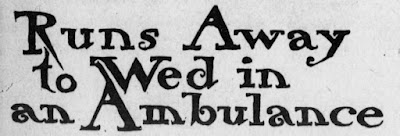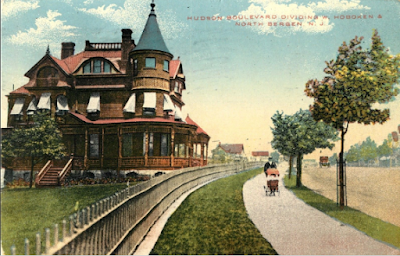The Bride, the Groom and the Ambulance
When we think of love, there are many examples we can conjure up. History has provided many great examples: Marc Anthony and Cleopatra, John and Abigail Adams Diego Rivera and Frida Kahlo, or Johnny Cash and June Carter, However, one example of love has been lost to history—a story for the ages, in fact. The idea of the runaway bride is a trope often seen in modern movies, but nearly 120 years ago, North Bergen was the backdrop of a love that could not be tamed. It had everything you needed for a classic romance story: forbidding parents, a young couple in love, a dramatic plan to marry, even a daring escape. The stories of Mary Kronberg and Julius Braun may not be Romeo and Juliet, but they are both cut from the same cloth.
How dramatic can love make us? For Mary Kronberg and Julius Braun, the answer is very. Young Mary, 17, and the Kronberg family live on 48 Main Street in North Bergen, a street that no longer exists today, but would be 25th Street if it did. In her own words, Mary was "locked up by her stern and solicitous parents to keep her from meeting or marrying the man of her choice." She continued, "I was locked in a donjon keep; guards in the person of my mother, father, relatives, and servants patrolled the walls." Her love, Julius Braun, a 22-year old ambulance driver, was forbidden from even approaching the Kronberg home. Yet, despite the attempts to keep the two star-crossed lovers apart, the attempts would be futile; they were ready to be married. When Mary discussed the idea of a marriage to Julius with her parents, she was "rushed into her attic boudoir and locked in." The Kronbergs told her to forget Julius, that Mary was too young and Julius, well, Julius was too poor. Mr. Kronberg gave orders to Julius Braun that "to approach the Kronberg domicile must be at his peril."
Through the course of several days, Mary attempted to devise a plan. "Mamma and papa were dead against my marrying Mr. Braun, and after I was locked in my room, I thought of a hundred plans to escape." Mary recalled in an interview that made national news. She racked her brain, trying to base a plan on the old romances of her day. Mary in North Bergen could not be more different from any of these. Heros crafting ropes of bedclothes, the knight in shining armor rescuing the fair maiden from a dragon or evil king, the cowboy saving a young girl from a runaway coach in the wild west could not apply to Mary in North Bergen, could they? Mary continued her brainstorming, and it hit her like a bolt of lightning when reading a newspaper one day. She explained, "The first thing that attracted my attention was an article about a woman who sprained her ankle while descending the stairs." The story was of a woman, home alone, injured, who phoned for help and was carried away by ambulance workers. Mary thought to herself, if I was "injured," why wouldn't I be carted away also? The idea fascinated her. She began to think of spraining an ankle or even breaking her arm! Yet could she really injure herself or, once at North Hudson Hospital, would the doctors discover the ruse? But then she had an epiphany. She realized she never needed to get to the hospital, but just have the ambulance arrive and somehow have Julius in it.
Mary and Julius's mutual friend, Albert Meyer, may have entered. Meyer also drove an ambulance. Mary admitted she stood at the top of the stairs in her home, but didn't have the courage to throw herself down to inflict an injury. Instead, she concocted a genius plan. She found an empty bottle of carbolic acid. Carbolic acid is a poisonous chemical made from tar. It was essentially created to kill germs, an early 20th century Lysol. The following morning, Mary instructed her brother to send for medicine. She wrote a letter to Albert Meyer explaining her plan and asking him to have Julius prepare for the daring escape to come. The plan called for Albert and Julius to arrive at the Kronberg home at 3 o'clock on August 12th. Albert delivered the "medicine," which was actually a vial of milk and signed off by Dr. "O.K."
It was then that Mary poured the milk into the carbolic acid vial, disarranged her room, tore down the shades, and worked herself into a sort of suicidal hallucination. At half past 2, she threw herself on the couch, holding the bottle in her hand, and began to shriek. Her mother and brother responded to the cries. "I moaned and groaned, slobbering as much as I could and yelling for all I was worth." Mary put on an act that most actresses would envy. She begged for an ambulance to take away the poison, bartering for her life as her helpless and unknowing mother looked on in despair, "I want to live!" Send for the ambulance! " Mary cried! As the charade continued, Mrs. Kronberg ran frantically for help, a memory which Mary recalled almost caused her to laugh. Mrs. Kronberg called North Hudson Hospital. Mary admitted that as her mother comforted her, a feeling of guilt overwhelmed her to the point where she almost gave herself up. "She promised me everything, and I began to feel pretty mean about my deception." However, the emotion was short-lived as the clang of the ambulance gong was heard in the distance.
Albert Meyer rushed through the front door as if there was no time to be lost. Meyer picked up Mary and carried her to the ambulance. Mrs. Kronberg wished to ride in the ambulance. Mary instructed Meyer to drive directly to Judge Frank J. Stuke's home, and with instruction, Meyer mounted his seat and put the horses to the gallop. Mary admitted to laughing during the ride as Meyer rattled the ambulance bells and shouted to those on the boulevard to get out of the road. The ambulance zigged and zagged through North Bergen, West Hoboken, and Union (West Hoboken and Union being present-day Union City) until it arrived at Judge Stuke's home at 212 Columbia Street, present-day 212 44th Street in Union City. Mary remembered, "Of course, Julius was waiting for me at Judge Stuke's house. He carried me in, wrapped in a blanket, just for the look of things, for I was fully dressed, and except for a hat, ready for my honeymoon trip. " In perhaps a world record, the two were married in just under five minutes. Mary, fully expecting Mr. and Mrs. Kronberg to be waiting outside of Judge Stuke's home, exited the home full of fright at the reaction of her parents. However, Julius arranged for a carriage to be waiting outside the home, and when they debuted as husband and wife, they were whisked away without a moment to waste to a departing trolley, which took them to the Lackawanna Train Station in Hoboken. They were transported away to beautiful Sullivan County, Pennsylvania for their honey moon.
The story does not end there. The new Mrs. Braun picked up the newspaper on August 13th to find she was the heroine of a national news story. Mary claimed she was happy her story was well known, for she knew "other girls are in just as bad a fix as I was in, and if they can get encouragement from my experience, they're welcome to it." Mary did say she had remorse for her actions, especially knowing that her mother and brother waited at the hospital for over an hour expecting the ambulance to arrive. Also for Albert Meyer, who had to break the news to Mrs. Kronberg, Mrs. Kronberg also received an earful. Mary wrote to her mother from a Pennsylvania hotel, and her mother sent her clothing and a care package. Mary and Julius returned back to North Bergen after their honeymoon. They did so in hopes of being forgiven, but they admitted they did nothing wrong, and that the Kronbergs knew that. In true fairy tale fashion, the Brauns lived happily ever after. Mary's parents welcomed Julius into the family. In the end, there simply wasn't any way to stop a girl and her sweetheart from getting married if they'd made up their minds.
Dedicated to my wife,
Emily Maring
Sources:
"Used An Ambulance For Their Bridal Coach." The Evening Journal. August 13, 1904.
"Elopes In Ambulance." The New York Tribune. August 14, 1904.
"Ambulance Brings the Bride." The Sun. August 1, 1904.
“Runs Away to Wed in an Ambulance.” Omaha Daily Bee. October 16, 1904.








Comments
Post a Comment